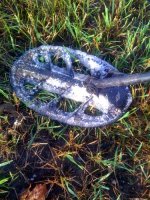I m not sure about the dust thing. If the dust was that bad your initial signal would all over and you'd be checking the plug and hole after popping the plug and having a hit on both sides. I always rescan my closed plugs, and have never has dust sound off on any of my detectors.
I think you misunderstood me.
Take a group of microscopic rust bits,,,scattered in the soil,,,,will a Vlf detector even detect with tone????
But this same material can in fact cause the detector (blind) it to find actual detectable nonferrous target.
You see,,,there are things affecting the detector in the soil,,,we have no real knowledge it's happening.
We only get falses,,or tones to give us clues,,,and even these don't tell the whole story of just what electronically is going on inside our detectors.
It does take a magnitude of signal of sorts to actually set a detector off tonally (probably varies between different models detectors). So phase shifting can be altered,,signal level compromised,,hence no real clues of detection of nonferrous find.
Maybe a good question here,,,,just how small a piece of ferrous material will a detector alert on,,,even using all metal,,,or using disc mode with 0 disc???
There are limits to size (how small) a nonferrous can be for detection,,,and these ultra small nonferrous bits I. E. Foil could also hamper detection of worthy finds.
Remember deeper targets,,small,,,hot spot on coil(receive) very small vs shallower,,,,a small alley way that can be obstructed unknowingly.
An experiment using the smallest shotgun shot size pellets,,using these would give clues to actual reality of what can and does happen.
Another example,,,take a Deus to a 250 year old site loaded with nails,,hunt it to death,,,keep hunting it,,,when you think you've got everything out.
If this site was left undisturbed,,,go back 10 years later with Deus,,,,could you find anything nonferrous??? Highly likely,,,why??? Because some of the iron has decomposed to the point it has less or no negative affects.
Now some targets could be found due to ground/soil shifting too.
So in a sense no site is dead,,,,just wait for ferrous to decompose,,,but there is another catch,,,sink rate,,,like say silver coin or gold coin,,,,sink rate could in fact outrun your detector's depth capabilities and time for select ferrous materials to decompose.
Imagine what some of the older sites uninhabited ,,,from a nail perspective will look/sound like 2000 years from now.


 ..
..